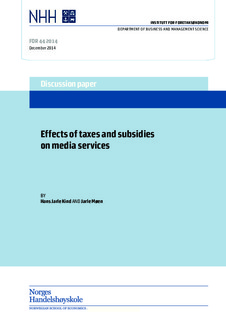| dc.description.abstract | We start out reviewing the justification for press subsidies. The social value of journalism can
be larger than what the newspapers are able to extract because of knowledge externalities,
public good characteristics of investigative journalism and non‐appropriability of consumer
surplus. A free market will then underinvest in journalism. Problems related to economies of
scale and scope further imply that the number of newspapers and their circulations may be
too small, while advertising can give newspapers too strong incentives to aim for the mass
market. According to the media economics literature, a preferential VAT regime provides
higher differentiation incentives for existing newspapers, while a tax deduction for editorial
expenses is well suited to increase journalistic investments. Micro economic theory further
indicates that fixed transfers is the most efficient instrument to reduce entry barriers and
avoid newspaper mortality, and that a subsidy per copy sold will increase circulation. We end
the article by summarizing empirical evidence on the effects of media support. | nb_NO |
